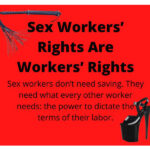The History of Laws Regulating Sex Work

Sex work is perhaps more commonly known around the world as ‘prostitution’; an outdated term which demeans a sector of the workforce so established and fundamental to societies regardless of religion, culture or custom that it is believed to one of the oldest surviving professions in the world.
Ancient societies
Anthropologists, sociologists and indeed archaeologists posit that in ancient hunter / gatherer societies, sex work was vital for many women who were shunned, outcast or exiled from established social structures to ensure the survival of themselves and any of their dependant children through the barter of goods for sexual services.
Indeed, surviving ancient Aramaic and Hebrew texts describe sexual services being exchanged for food including small game and, in one recorded instance, even a goat.
The practice was tolerated albeit looked down upon in many civilisations, where practitioners were often seen as second-class citizens, although not criminalised for providing their services.
Ancient Anecdotes
Sacred sex work is where sexual acts are performed for sacred purposes, including as a tribute to deities.
Literature by the ancient historian Herodotus suggests that ‘sacred prostitution’ was common in many civilisations around 2400 BCE.
He provides accounts of fertlity rituals in Sumer and later in Babylon, whereby temple priestesses had sex with male visitors as a tribute to the Gods and Goddesses, to release divine fertile energy and ensure a plentiful harvest.
For their part, Sumerian priests in the city of Uruk operated a brothel from their temple, or Kakum.
The influence of the Sumerians on ensuing civilisations cannot be underestimated. Indeed, one of their most notable inventions is calculating time as we know it today, by dividing the day into hours, hours into minutes and minutes into seconds.
The civilisation ceased to independently exist when the Amorites, the Indigenous people of central inland and northern Syria, integrated within their communities.
Sacred sex work was later practised by several other civilisations including in China, Japan, Greece and Rome.
Early signs of discrimination against sex workers
The first records of discrimination against sex workers are also from around 2400 BCE.
Indeed, there are records of the temple dedicated to the goddess Ishtar – worshipped by the Sumerians under the name of Inanna – was segregated the sex workers into 3 distinct classes, to which different rules applied.
First class permitted sex inside the temple, second class allowed sex in the grounds of the temple, where visitors could be serviced and third class catered for customers from the streets.
In Sardinian, Phoenician and Canaan cultures, which worshipped the goddess of sexual love and fertility, Ashtart, many sex workers in temples were male.
Phoenicia is mostly situated in modern Lebanon and Canann now includes Israel, Gaza, Jordan and parts of Syria & Lebanon.
Sex work farms – the genesis of sex trafficking?
The Roman Empire during the 4th century’s ambivalence towards pleasure, appears to take a turn towards depravity, including paedophilia and pederasty, when abandoned children were raised by what were known as sex worker farmers.
Though said in some circles to have been approved by the Roman government at that time, cogent evidence is difficult to find to substantiate the claim, although strong anecdotal evidence is in abundance.
This included corrupt orphanages, however this not only occurred in the Roman Empire, but throughout the ancient world and then, the modern world.
Many children were forced into sex work by their parents, and some were sold to slave owners as their parents were too poor to feed and clothe them.
It is also suggested that child sex work was institutionalised, with the Roman government taxing what is now known to be highly immoral, permanently damaging exploitation.
Needless to say, such acts would be considered child sexual offences today and heavily penalised.
As Roman law dictated, the children belonged to the father firstly and the mother next as their property, the father was able and apparently in some instances willing to sell the sex work of their daughters, as it allowed them to look after them.
Philosophical thought on pederasty
Two of the most famous philosophers of all time, Plato and Aristotle, according to Professor Brett Kahr, a Senior Fellow at the Tavistock Institute of Medical Psychology in London, wrote about anal sexual intercourse with young children.
Kahr, a historian in his own right went on to state that the ancient Roman use of children was accepted and was integrated into Roman culture at that time.
It appears that there was a dedicated public holiday for child sex workers.
Through the ages, we have come to realise that paedophilia has been a constant hidden pandemic and not only in ancient Rome.
Little absolute cogent material is available on the subject, of Roman sex work farms, though the archaeological and anecdotal evidence makes it seem likely to have some basis in truth. But, to what extent?
Taxing sex work
Commencing with Emperor Constantine in the 321s AD, with Christianity taking a stronger hold, sacred sex work reduced, at least within some temples in Rome.
Ancient Greece, Rome & Japan were the first amongst countless countries who introduced a taxation system for sex workers.
Historians suggest that mythical stories refer to sex workers playing a part in Roman Religious Ceremonies; presided over by Venus, the God of Love & Fertility.
Caligula was the first Roman Emperor to try to legitimise sex work as a business, by creating a tax on the industry which remained for 450 years, until it was abolished in the late 4th century by Emperor Theodosius.
Sex work within the Aztec civilisation
The ancient Aztecs who also had sacred sex work and operated buildings called Cihuacalli, which in addition to catering for religious people, also serviced politicians.
The Aztec goddess of sexual impurity and sinful behaviour, Tlazolteotl, was the deity to whom the Aztecs prayed for absolution.
And like many nations who prayed to the vast array of gods and goddesses available, prayed for a good harvest also.
The Aztec race settled in central Mexico in the 13th century, but no one is sure where they came from, apart from a place called Aztlan.
Speculation puts Aztlan in northern Mexico, or New Mexico, Arizona, or California.
Sex work within the Incan civilisation
The Inca Empire appeared to be another civilisation which regulated the industry, by having the brothels under the control of a government employee, though by that time, several countries appeared to have some degree of government oversight.
This was a civilisation which occupied modern day Peru and Chile, focussing on the Andes Mountains.
It existed for less than a century, but in its day, was the largest empire in the world at that time, with approximately 10 million citizens, albeit speaking in approximately 100 different languages.
Both the Aztec and Incan civilisations segregated sex workers, both female and male from the general population and had soldiers guard them in special accommodation.
Sex workers in these two societies were not slaves and access to them was via government officials.
The Aztec and Incan sex work was heavily regulated and sex workers taxed.
Declared a sin and criminalised
In the 7th century, however, Muhammad ibn Abdullah, the Arab religious and political founder of the religion of Islam, pronounced sex work as a sin.
As laws gradually became based on the religion, sex work was criminalised in Muslim societies with those found guilty being subjected to varying degrees of punishment.
Acceptance and regulation of sex industry in Christian nations
During the Middle Ages, a combination of ownership by religious entities, the toleration of it by other churches, amongst them the Catholic Church, which suggested that sex work reduced the incidence of masturbation, sodomy and even rape; saw the commencement of specific areas permitted for sex work to take place.
For example, the Bishop of Winchester owned brothels in Southwark, London.
All this, despite religion, including the Protestant Reformation endeavouring to stamp out, or at least reduce sex work throughout Europe.
The Protestant Reformation came about when a German monk challenged the Catholic Church’s philosophies in 1507, in a movement which swept through Europe and then the rest of the world.
A major impetus for this was not only as a result of the perceived sinfulness of it, but the potential for preventing similar pandemics of sexually transmitted disease, such as the plague of Syphilis which had swept across Europe in 1494, having started in Naples.
However, none of this, including the 30-year war, which is believed to have commenced in 1618 and was initially a religious war between Roman Catholics and Protestants in Germany, stopped sex work from progressing.
This war was triggered by the Holy Roman Emperor, Ferdinand II attempting to force Catholicism on his subjects, but it soon became political and involved many countries.
And still, sex work survived and prospered, with much heartache and misery for millions of slaves and others who were forced into it; including children of the slaves, who were raised to be sex workers, throughout the world!
The treaty, or two peace treaties called the Peace of Westphalia, ended the 30-year war in 1648, in which up to 8 million people were killed.
Benefiting economically from sex industry
Legislation relating to sex work was introduced in many societies through the centuries, bringing regulation and enabling governments to tax sex workers and thereby reap the financial benefits.
Acts of Parliament such as the UK Contagious Diseases Acts 1864, 66, 68 & 69 forced sex workers to be registered and subject to medical examination.
All these Acts to make sure the British Army and Navy were ready for war action and did not contract venereal disease from sex workers.
It would have been less trouble confining the soldiers to their barracks and the sailors to their ships.
This led to instances of not only some sex workers, but other women simply suspected of being a sex worker, confined to secure hospitals for enforced treatment of sexually transmitted diseases (STD), until it was repealed in 1886.
However, during the 2nd century BCE, ancient Rome registered its sex workers and issued licences to practice their chosen, or otherwise profession.
So, everyone else was a long way behind!
Australia
Australia, though initially subject to UK Law, were involved in introducing numerous pieces of legislation through 3 distinct periods, defined as, the convict, late colonial and post federation periods.
Convict period (1788 – 1840) in which English Common Law applied and covered brothels which saw some of the First Fleet deportees ply their craft.
Late Colonial (1840 – 1901) dealt with the health aspect, via the Contagious Diseases Act, in an effort to control venereal disease generally and in the military.
This resulted in compulsory medical inspections of women and those suspected of engaging in sex work would be locked in a hospital until discharged by a doctor.
This was repealed about 20 years later, when many countries brought in Sexual Offences Acts (SOA).
Post Federation (1901 – 1970s) – criminalising sex work
New South Wales in 1979, saw the commencement of the decriminalisation of sex work, but there was much more to follow.
A Point of Interest:
The Vagrancy Act 1835 (NSW) when it was a colony, initiated the criminalisation of sex work in NSW.
It also permitted police to arrest the unemployed, alcoholic and Caucasian people associating with Aboriginals.
Initially, after Federation, the 1902 Vagrancy Act still included Caucasians associating with First Nation Peoples. Such a travesty of inclusiveness.
By 1995, most aspects of sex work in New South Wales had been decriminalised, with brothels regulated by local councils similar to all other businesses, with the passing of the Disorderly Houses Amendment Act 1995(NSW), which amended the Disorderly Houses Act 1943
Thereby, effectively removing the criminalisation of brothel owners, including staff, living off the earnings of sex workers and the running of brothels.
Myths, Politics & Plaudits of Sex Work
WHO (World Health Organisation) report that between 35 and 45 million people world-wide died from AIDS & HIV. However, it would have been more, if not for our sex workers.
Whilst the sex work industry was not held responsible for the introduction of this pandemic, it was held accountable for being a Super spreader.
Though, in many instances, this might be considered accurate, what is not well known about many of the reported 40 million sex workers world-wide, is the contribution they made to a cure against the death of many with this illness.
Not as dramatic as it sounds, or is it?
Taking part in Evidence-Based Scientific Medical Research, millions of sex workers, male, female and LGBTI, actually significantly contributed to controlling this pandemic.
Such utilitarian involvement by sex workers, presented to the Global AIDS & HIV Conference in Paris and published in the reputable Lancet Medical Journal in 1986, led to changes in political, public and medical policies.
This resulted in the pioneering of Harm Reduction Educational Programs, necessary for reducing deaths and serious illnesses caused by this virus.
One other significant contribution, the consequence of such critical involvement by the sex industry, was that it reduced public hysteria.
This, according to many criminal justice organisations, also significantly reduced violence against many minority groups, which had been, ignorantly, blamed for the transmission of this disease.
We know only too well how public hysteria led to violent attacks on Asians, being unreasonably and illogically blamed for the Covid-19 pandemic.
Many of those attacked had actually been born and bred Australians. Literally thousands of people had been verbally and physically assaulted.
The Joint United Nations Programme on HIV/AIDS (UNAIDS), World Health Organisation (WHO), Amnesty International (AI), Human Rights Watch (HRW), United Nations Population Fund (UNFPA) and medical journals, such as Lancet; all concur that the decriminalisation of the industry assists in the control of HIV/AIDS.
Such organisations also state that this legally entitles sex workers to health services, further reducing the transmission of other STD’s.
Some global studies suggest that it also allows sex workers to report criminal acts against them to the authorities, potentially reducing the propensity for similar crimes against other members of society.
Equally important is that it assists in the global fight against sex trafficking.
Contraception
Various forms of contraception exist and all have varying degrees of success in preventing unwanted births.
Condoms
It is suggested that the first use of contraception via a condom, was when King Minos of Crete around 3000 BCE used one which consisted of the bladder of a goat, with linen being the material of Egyptian sheaves located in 1000 AD.
King Minos also featured in the female form of contraception, as his physician as the story goes developed a sort of diaphragm due to the mythological animals in the sperm of the King.
Enough said, for that is just a story!
However, the first verifiable documented use appears to be 1564, when Italian anatomist, Gabriele Falloppio, the person who pioneered the fallopian tubes, explained in detail precisely what a condom did.
The Romans also get a mention for pioneering it.
1785 is when the first mention of rubber condoms makes an appearance, until about the 1920s saw the introduction of latex as the most viable material of the modern condom.
Diaphragms
There is some speculation about which nation first introduced the female form of contraception, the diaphragm, with the African, Jewish and British nations all featured. Oh yes and some others. The important thing is that it was invented!
Spermicides
The unusual and perhaps unhygienic substances associated with the first recorded usage of spermicides around 1850, were sodium carbonate, animal dung and honey.
Intrauterine device (IUD)
The initial decades of this form of contraception considered the device both dangerous (as a result of infection) and actually ineffective, until approximately the 1960s, when construction and material slowly but surely showed improvement in some IUDs.
After several more decades of design, the IUD was brought into line with the other forms of reliable contraception.
It was apparently more effective when used in a primitive way in the Middle East centuries ago, when it was used to prevent camels from becoming pregnant.
The pill
Then, contraception utopia arrived, by the introduction of the contraception pill, created by a combination of two physicians about a decade apart, Dr Djerassi and Dr Pincus.
At first in some jurisdictions, only married women could be prescribed it, until it later became available to every woman.
There are several other methods, such as a contraceptive injection, implant or patch and a cap, depending on the requirements which may suit best.
Potentially lucrative work
It is nigh on impossible to estimate with any clarity what a sex worker earns in a year. Whilst the profession, in the main, is regulated, there are many add-ons to the services which are provided and too difficult to police, to be confident of even coming close to an accurate figure.
What can be said, is that it is certainly a multi-billion-dollar business in Australia, if not more!
IBISWorld is a global company which specialises in providing a complete range of expert advice to reputable global financial, accounting and legal companies, amongst other industries.
IBISWorld has offices in New York, Melbourne, Los Angeles, London, Frankfurt and Beijing and service a ‘who’s who’ of global clients.
Therefore, their figures are as close as we are capable of getting.
Sex industry in Australia
The market size of the Brothel Keeping and Sex Worker Services industry in Australia for 2022, is $152.6m.
It is expected to increase by 21.9% in 2022.
The last 5 years has seen an annual decrease in revenue of 0.9%, with a decline over the past 5 years being quicker than the economy overall.
The above figures include:
- Licensed brothel operation
- Licensed brothel keeping
- Sexual services
- Escort agency services
- Erotic massage services
The figures do not include:
- Stripping
- Erotic dancing
- Adult internet services
- Telephone sex chat lines
- Making and retailing adult video entertainment
- Manufacturing adult video
- Retailing sexual aids
Binjun Xie, an alleged Chinese Triad, heads a seemingly nefarious international operation being investigated for sex work-related offences, including modern slavery.
Hammer as he is known by, appears to have manipulated the Border Force system in a number of ways, involving it would appear, widespread official corruption at worst, downright dereliction of duty at best.






